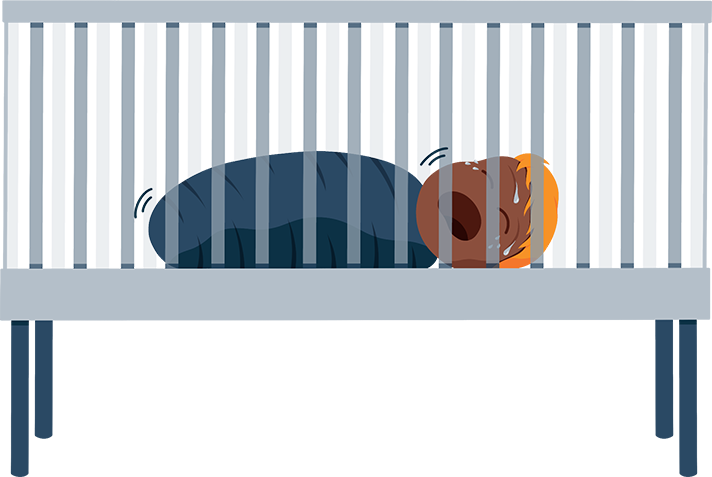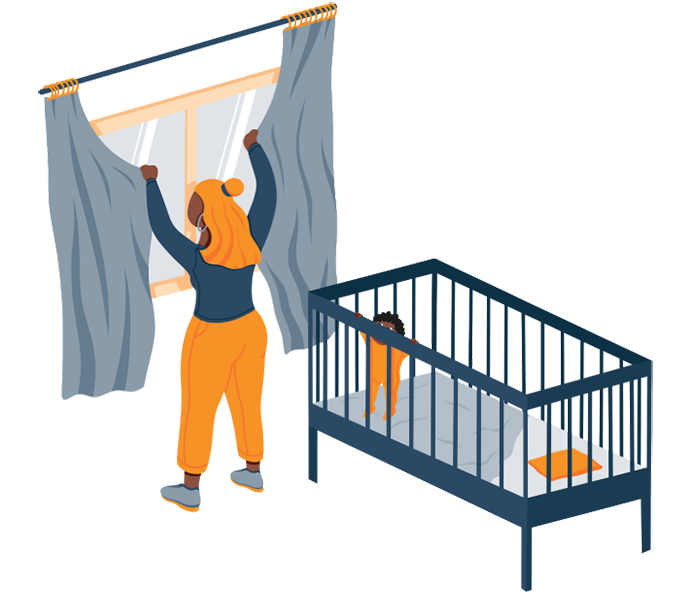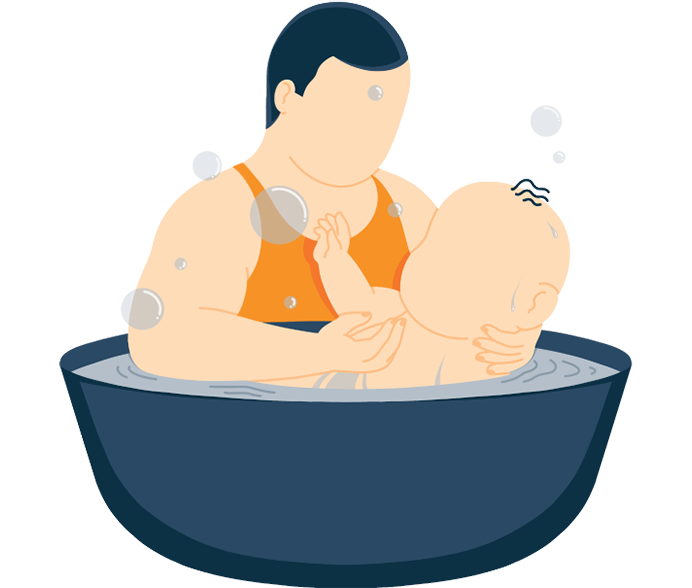As much as you love holding your new, little bundle in your arms, there comes a time for every new parent when the need for a good night’s rest takes over. This article aims to answer a common question from new parents: How to get my baby to sleep in a crib?
Teaching your newborn to sleep in their crib can be challenging—for both of you.
If done right, the transitional process can be smooth without all the commonly associated hassle, and by following some techniques on how to get your baby to sleep in a crib, your newborn should be able to get used to their new sleep environment easily. You don’t have to go through weeks of constant crying and moodiness.
Although it may seem difficult at first, both of you will be more rested and happy in the long run. Let’s take a look at the most common questions below:
When Should My Baby Start Sleeping In a Crib?
This is a common question, but it’s also the one that doesn’t have a straight answer. It would pretty much depend on how old your baby is as well as how comfortable you are with him sleeping separately.
The truth is that parents have hard times the first few nights, even if the baby sleeps well and he’s not bothered by the drastic change. It would be a good idea to put his or her crib in your room for the first few weeks. This will get you used to the infant’s breathing noises, hunger signals, and sleeping patterns.
This period usually takes about a year. Keep in mind that there is certain research which shows that babies have a significantly lower risk of developing SIDS when they sleep on a firm crib mattress on their back in the same room with their parents.
Some parents, however, are comfortable with moving the crib in a separate bedroom only after a few months. This could also be a solution if the baby’s sleeping patterns allow it and there’s nothing to be worried about. However, you should use a monitor to make sure that everything is closely observed.
Explore: Best Crib Mattress
Why Does My Baby Cry When I Put Them In?
The truth is that there are quite a few different reasons for which a newborn might actually cry as soon as you put them in the crib. Let’s have a look at some of them.
One reason could be that your baby just isn’t used to it. Maybe your little one has slept in your bed for months, and that’s what he or she is comfortable with. As a new parent, it can be hard to put your baby down when they finally get to sleep—rather than teaching your baby to be able to sleep on their own, though, you might be perpetuating the problem.
Their new environment, regardless of whether the crib is in the same room or not, might seem like a stressful place because they are not used to it.
Another might be acid reflux or food allergies. More than half of babies are estimated to experience acid reflux to some degree, which can be an unpleasant experience when laying down for the night especially. Now, it’s important to note that this is not always an issue, but some babies have certain food allergies which might actually make it rather impossible to spend time on their backs.
If you try to get your infant to sleep in the crib and he or she experiences this chronic heartburn, this is definitely going to result in a lot of crying. Be sure to check with your doctor if you think your baby has either of these problems.
It can be hard to overcome these issues, but it’s not impossible.
Why Does My Newborn Only Sleep When Held?
Now, the easy answer to this question is because your child is used to it. But that’s not the only thing to consider—you are also used to it. A lot of parents wouldn’t feel comfortable with their babies falling asleep anywhere but in their arms.
If sleeping in your arms is a habit, it can be hard for baby to fall or stay asleep by themselves (afterall, you are the best snuggle buddy). There is nothing wrong with cuddling your newborn—you truly can’t spoil them—but for you to get the rest that you need, you might need your arms free.
You can start small by putting your baby down in their crib when they are very drowsy but still awake for one nap a day. The more you do this, the more that they will get used to being able to fall asleep and stay asleep in their own space. While older children can be sleep-trained, newborns should not be, so if your baby seems like they are in distress, don’t be afraid to soothe them.
Read More: Is it Safe to Sleep With My Baby on My Chest?
Is it Safe to Stop Cosleeping?
Safety-wise, there’s nothing that you should be worried about. The most important thing that you have to consider if you want to enable your newborn to start sleeping on their own is how comfortable they and you are. It can be emotional for both of you when you choose to stop co-sleeping, so if you have decided that this is best for your family, don’t be afraid to start slow.
If you are sharing a bed, move baby’s crib into your room by your bed and lay them in there. Once he or she gets used to that sleeping environment, you can slowly introduce them to the new world, which would be a separate bedroom, when you are ready.
Baby monitors can help you rest a bit easier once you make the move. You will be able to check on them and be aware of what’s going on whenever you’d like.
Want to know more? Read our safe co-sleeping guide here.
Tips on How to Transition an Infant to Sleep in a Crib
Make it Feel Like “Mommy”
For you to make sure that little one gets used to the crib quickly and transitions from co-sleeping, you might want to make their new environment as close to the one that they are used to. The thing about infants is that they comprehend the surrounding world in a very sensory fashion. Therefore, if you manage to replicate the warmth, coziness, and the sounds that your baby gets to experience while sleeping with you, there should be less opposition.
Avoid putting a pillow, blanket, or a lovey in the crib with your newborn child because it increases the risk of suffocation. Sleep sacks and swaddles work wonders to keep those little arms contained as if they are being held. Sound machines can give baby the illusion that they are close to your body.
If the little one is still protesting, stand there for a few minutes and place your hand on their chest to soothe. Pacifiers can satisfy their need for comfort as well.
Find Out More: How To Keep Your Sleeping Baby Safe
Start With Naps
An easy transition would be one predicated on experiences which the baby is already used to. Nights can be long and hard when over-exhausted, so it might be a good idea to start practicing with naps every now and then, at least once a day.
This should allow for a quicker and far smoother transition because baby will start getting used to sleeping in a new environment while you have a clearer head rather than in the middle of the night when you are probably begging for sleep.
Create a Bedtime Routine
As we mentioned above, babies perceive the world in a sensory manner. Therefore, if you want to make the sleep-in-crib transition a lot easier and far more accepted, you should create a routine that your baby can start predicting and get used to. Routines enable him or her to anticipate the crib, even at only a few weeks old!
Make sure that the baby bedtime routine is fun, stress-free, has multiple steps, and it transitions to bedtime. It doesn’t have to be anything too crazy. An example could be nurse, bath, pajamas, story, sleep—whatever works best for your family.
Include a Snack
Try to include a feeding before you put your child to sleep, but try not to let them fall asleep in the middle of it. If the baby is over six months, you could also add 1 or 2 tablespoons of cereal in the meal. Make sure that you don’t overdo it, because an overfilled tummy will likely cause them discomfort.
Give Them a Bath
A bath can naturally ease your little one into sleep. If bathtime is more stress than relaxation, it does not have to be included in the bedtime routine.
To make the experience more enjoyable, stick the towel in the dryer for a few minutes before you take them out of the bath. That way, it will be warm while you dry them off once they are all clean.
Read a Book
The calmness of your voice is something that could easily get your kid into a sleepy state. Even though younger babies are unlikely to understand what you are actually reading, the soothing tones and rhythms will likely help prepare them for sleep. Plus, reading to babies has been shown to improve vocabulary and speech later in their lives, according to the Journal of Developmental & Behavioral Pediatrics.
Conclusion
Getting your newborn to sleep in the crib doesn’t have to be a daunting task that many parents fear. These steps should make the move to a crib smoother and simpler.
Make sure that everything is handled in a gradual manner, one that is going to make the baby—and you—comfortable. And above all, enjoy those newborn snuggles while you can!
Sources and References:
Jill Zwarensteyn
Editor
About Author
Jill Zwarensteyn is the Editor for Sleep Advisor and a Certified Sleep Science Coach. She is enthusiastic about providing helpful and engaging information on all things sleep and wellness.
Combination Sleeper



